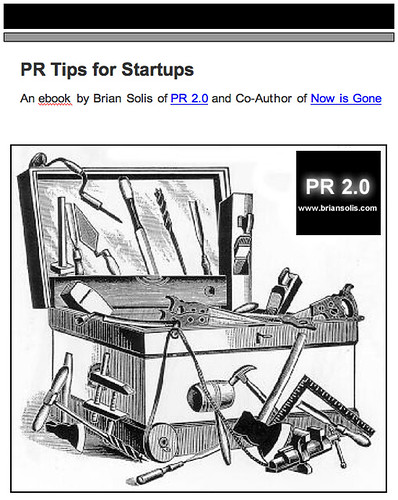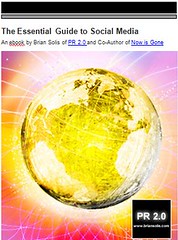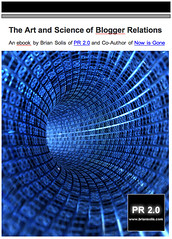The Evolution of Social Media Releases

Maggie Fox released a new Social Media service called Digital Snippits(tm). Congratulations Maggie, it’s a very polished and useful solution that will help your clients expand their options when running proactive communications campaigns. And, I’m being genuine when I say that Maggie has done a great job. She's gets it…
The rest of this discussion is aimed at everyone who is looking to learn more about SMRs and how to improve press releases in general.
For all of those who have been part of this exhaustive process of “pushing a boulder uphill,” as Chris Heuer so appropriately put it. I think we all agree that this is a positive release and an opportunity to bring the conversation into the spotlight in order to learn from one another. It is also comparable to a variety of tools and solutions that are available today. But, I'm not here to compare everyone's work, only to acknowledge individual achievements along with the great work contributed by others.
What we don't need to do is overlook noteworthy contributions over the last 20 months. That way we don't take away credit from those whose advancements have paved the way for everyone else. At the same time, most of the industry is still shaking their heads wondering what all of this means...so what are we going to do about it?

Geoff Livingston is right when he says, “Old-timers in social media need to realize that innovation and adoption will occur with or without them.”
Where I differ with him on opinion is when he continues, “They would be better served embracing these people, and making their past content easily available than kvetching about how no one researches. History means nothing when people with two years, two months or two days of social media experience are trying to create a solution that will work for their companies and paying clients.”
I do agree with embracing new ideas and those who create them. And for the most part, I think we all do…maybe to a fault. We also get dinged for creating a so-called social media love fest that sometimes eclipses the value of what the collective of great minds produces.
Regardless of money and paying clients, it is important to remember that history lessons prevent us from repeating mistakes in the future. It also eliminates celebrating the reinvention of the wheel. And, research aka "getting smarter" also serves as a foundation for legitimate evolution in a rapidly changing media landscape. We’re talking about social media here, not just about the latest shiny new object. There’s real value in the stuff that happens behind the scenes and as we’ve all learned, companies can make mistakes and customers are quick to call them on it.
There are consequences.

Why do I care?
This isn’t just about PR for the SMR.
There’s a tremendous amount of confusion out there and the community is working independently at a time when we should be working together to help people. It’s only widening the gap between the people who do get it and the people that don’t. Narrowing that gap is a personal objective for me across all forms of Social Media.
The only reason I run this blog is to spotlight the evolution in New Media, Social Media and also traditional Public Relations to bring things from the edge to the center so we can all learn and grow together.
Almost two years ago, Todd Defren released the SHIFT template in response to Tom Foremski’s call for evolution. Todd graciously offered it up as an “open source” document to help the entire PR industry do something new and at the same time, re-examine the way they write traditional press releases.
How did the PR industry respond?
- Many pushed back.
- Others defended it.
- Most just didn't know what to do with it, and it continues today.
- Some PR and New Media agencies and consultants saw the opportunity to rebrand it as a differentiated service> This may be one of the main reasons that we don’t see many case studies available to the public as it could now be considered a competitive edge.
- A small group of people banded together to help build a community around it to help the rest of the industry get it.
I’m part of that small group which includes Chris Heuer, Shannon Whitley, Tom Foremski, Todd Defren, Shel Holtz, Todd Van Hoosear, among others. Together we founded the New Media Release Workgroup with the original charter of creating an open standard technology base for creating and distributing SMRs. The product would eventually be called the hrelease.
We looked for participation from PR practitioners, wire distribution services, geeks within the microformats community, bloggers, and reporters.
To this day, the WorkGroup moves forward under the leadership and perseverance of Shannon Whitley. Members include, Alison Minaglia, Andy Arnold, Dan Zarrella, David Weiner, David Parmet, Jason Ryan, Michael O'Connor Clarke, Paul Dyer, Paul Pritchard, Steve Kayser, Susan Watiker, Todd Van Hoosear, and me.
I'm happy to report that there are good things to come. You can also join the discussion with advice, insight, and quesitons on Social Media Releases and the hrelease format on Google.
With every new SMR discussion it's good to go back to the beginning to unearth the case for SMRs from the archives, dust them off, and spotlight two years of invaluable discussions to set an equal foundation for everyone currently standing in the same room.

There is tremendous brilliance in those discussions and not embracing them is like trying to practice law without referring to past cases.
For a quick study, see “Everything you wanted to know and should know about Social Media Releases.”
The most important and consitent points that emerge are:
- Why an SMR?
- How do you build one to look like the existing template?
- Does it need to have bullets?
- Why another release?
- Has anyone asked journalists if this is what they want?
- How do you send one out?
- Do SMRs replace traditional releases?
- How do SMRs comply with RegFD?
- What’s the difference between a traditional release, multimedia release, and a social media release?
- Should conversations be hosted or should they be encourage through individual communities?
- Could an SMR be a Web page or should it be hosted on a Social Media platform?
- Does adding RSS, embedded content, widgets, links to external social networks, images, videos, bookmarks, etc. make a release “social?”
- Where are the case studies?
These are all incredibly relevant questions to this day. So, let’s take a step back to remember how and why this started in the first place and why it isn’t going away.
Press releases are 100 years old and reporters, and now bloggers, have been complaining about their uselessness for years. Over the years, PR got caught up in buzzwords, hyperbole, spin, and caused an inability to easily build a story from them, which was supposed their intent and sole purpose all along.
SMRs aka SMPRs are not the miracle cure for the ills that plague a majority of press releases.

Todd Defren was the latest person to take the tools of today to help PR tell a story in a way that gives the media what they need so they can assemble the story their way, without having to first deconstruct, research it, and reconstruct it. There have been champions for change and improvement over the decades.
Whether it’s Social, Traditional, or Multimedia, it all starts with what you have to say and how you say it.
Instead of presenting aggregate pieces, bullets and facts, you could very well write the story you want to read. For example, I've experimented with SMRs which were basically "branded" blog posts that read exactly like the story we hoped to see, minus the gratuitous BS and unecessary posturing found in most traditional releases. When hosted on a blog platform, in this case, WordPress, they an inherently operating in a Social Ecosystem. They're an extension of a company press center and each release aka post, feature embedded video demos, audio interviews and sound bytes, artwork, etc. all sourced from the various networks where we ALSO place them for additional exposure. We share them under password protection and after the embargo passes, the post appears to the public. To everyone else, it looks like just another blog article...but to those in the PR business, it's easy to see the connection to what we talk about in a Social Media Release. Each one distributes through blog search engines and also features RSS, bookmarks, tags, trackbacks, comments, widgets, embed codes, and all other pertinent social building blocks. The press and bloggers we've worked with absolutely love it.
But, let’s not confuse SMRs with Social Media.
But remember, they don't want to be pitched or marketed "at."
SMRs are only meant to deliver information in a way that not only helps media write stories, but a bonus effect of good Press Releases, regardless of format, is that they enjoy additional exposure through search engines. Why not use it to facilitate conversations. It is a Social Media Release after all, and Social Media is defined by any tool that hosts and encourages conversations on the Web.

Again, if you can distill the essence of your story in a way that matters to the very people you’re trying to compel, then why wouldn’t you change how you do things? It could only expand your reach and help you improve blogger, media and customer relations. In the new world of PR, they are intertwined.
Social media releases, to me, expand the discussion beyond form versus function and forces us to examine why we need to explore additional options and what we can bring to the table in return.
One thing to think about in any discussion related to traditional or social media releases is that stats show that good releases ARE the central point of consumption, "conversations," and more importantly, a catalyst for "action" courtesy of search engines.

In the tech world, numbers show as much as 51% of IT professionals discover news and information from press releases found in Google or Yahoo over trade journals. That's pretty compelling...and it's the activity and discussions inside the bubble that keep a level playing field in order for it to effectively influence the rest of the industry.
With stats like that, it starts to show you several things...1. Press releases are far from dead. 2. One press release doesn't serve everyone. 3. There are now press releases for journalists and bloggers as well as story-based releases directly for customers.
And, when you break it down, as of now, there are search engines that comb through traditional HTML web sites and there are search engines that monitor blogs, wikis, and other forms of social media.
If customers are searching for information, make sure you have a social and traditional strategy in place and think about the content, context and building the social bridges that reach them. You might write for customers differently than you would for media and you should consider utilizing all forms of releases available to you. After all, one message doesn’t fit all…
Maggie's keeping the discussion going...if anything, we should consider that "social" in the social media release implies conversation...whether hosted internally or externally. An SMR is an ideal beacon for all of those conversations and can serve as a hub for flourishing thoughts, ideas, and opportunities for customer service and also a magnifying glass into the dialog within their online communities.
At the end of the day, take from all of this what applies and matters to the people you’re trying to reach – media, bloggers, and customers. None of these options are magic bullets. You still have to do your homework and reverse engineer the distribution channels that reach journalists, bloggers and customers, nderstand what they need, and why they should listen to you, and in turn, share information within their own social networks.
Other voices on the subject:
Chris Heuer on the history of the SMR.
Shannon Whitley on Digital Snippits and PRX Builder.
Chris Heuer, Paul Gillin, Jason Falls, and Geoff Livingston on the Digital Snippits.
Geoff Livingston shares 9 points for evolving SMRs.
Connect with me on Twitter, Jaiku, Pownce, Plaxo, or Facebook.
pr public+relations pr2.0 2.0 marketing smr socialmediarelease social+media+release social media release press+release media+release media2.0 media+2.0 new+media new communications publicity hrelease bloggers blog journalists press






















